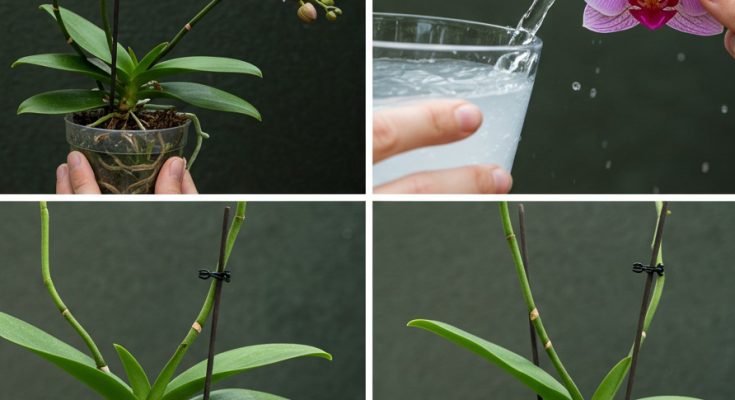This article reveals a simple but effective method to bring a weak, rootless orchid back to life. Whether you are a beginner or an experienced grower, understanding how to nurture orchids through this vulnerable phase can save your plant and restore its health.
Why Do Orchids Lose Their Roots?
Before diving into the revival method, it’s important to understand why orchids lose roots in the first place. Orchids have delicate, specialized roots designed to absorb moisture and nutrients from the air and growing medium. These roots are prone to damage from:
-
-
Overwatering or poor drainage leading to root rot
-
Fungal or bacterial infections
-
Inappropriate potting media that retains too much moisture
-
-
Physical damage during repotting or handling
-
Lack of humidity or improper environmental conditions
When roots become damaged or die off, the orchid struggles to take up water and nutrients, causing the leaves to wilt, yellow, or drop.
Signs Your Orchid Needs Root Revival
If your orchid shows one or more of these signs, it’s time to intervene:
-
-
Leaves are limp, wrinkled, or soft
-
Roots are brown, mushy, or completely missing
-
The plant looks shriveled or weak
-
-
Growth has stopped or slowed dramatically
Don’t give up on your orchid just because it looks bad — orchids are surprisingly resilient and can bounce back with proper care.
The Method to Revive a Weak, Rootless Orchid
The key to helping a rootless orchid come back to life is to provide it with an environment that encourages root regeneration while reducing stress on the plant. Here’s a step-by-step guide:
1. Remove the Orchid from Its Old Pot and Inspect Roots
Carefully take the orchid out of its pot and examine the roots. Use sterile scissors or pruning shears to trim away any dead, mushy, or blackened roots. Be gentle to avoid damaging healthy tissue.
2. Clean the Plant and Pot
Rinse the orchid’s roots and leaves gently with lukewarm water to remove old media and any fungal spores. Clean the pot or prepare a new pot with fresh, well-draining orchid mix.
3. Prepare a Supportive Growing Medium
For rootless orchids, using a moisture-retentive but airy medium is important. Sphagnum moss is ideal because it retains moisture without suffocating roots. You can also mix sphagnum moss with bark chips for better aeration.
Soak the sphagnum moss in water and squeeze out excess moisture until it’s damp but not dripping wet.
4. Repot the Orchid Carefully
Place a small layer of the damp sphagnum moss at the bottom of the pot. Position the orchid so that its base is stable and gently fill around the roots (or rootless base) with more moss. The moss will keep the plant moist and encourage new root growth.
Additional Tips to Support Root Growth
-
-
Humidity: Orchids thrive in humidity around 50-70%. Use a humidity tray, mist the plant regularly, or keep it in a bathroom or kitchen where moisture is higher.
-
Light: Provide bright, indirect sunlight. Avoid direct harsh sun which can dry out the plant.
-
Watering: Water sparingly but consistently. Keep the moss moist but not soggy. Overwatering leads to rot, so let the top dry slightly between watering.
-
-
-
Temperature: Maintain warm temperatures between 65-80°F (18-27°C). Avoid cold drafts or sudden temperature changes.
-
Air Circulation: Good airflow reduces fungal risk but avoid strong drafts.
-
Fertilizing: Once new roots appear (usually after a few weeks), feed your orchid with a diluted orchid fertilizer every 2-4 weeks during the growing season.
-
How Long Does It Take for New Roots to Grow?
Patience is essential when reviving orchids. It may take several weeks to a few months before new roots start to appear. During this time, focus on stable care, maintaining humidity, and avoiding stress factors.
Once you see fresh green roots, it means your orchid is on the path to recovery. At this point, you can gradually adjust watering and fertilizing to encourage further growth and flowering.
Common Mistakes to Avoid
-
-
Overwatering: This is the most common cause of root loss. Always ensure proper drainage and never let the orchid sit in standing water.
-
Using the wrong medium: Avoid heavy or water-retentive soils not designed for orchids; these cause root suffocation.
-
-
Neglecting humidity: Dry air slows root development.
-
Ignoring signs of pests or disease: Treat issues promptly with appropriate methods to prevent further damage.
Conclusion
Reviving a weak, rootless orchid is entirely possible with the right approach. By removing dead roots, repotting in a supportive medium like damp sphagnum moss, and maintaining ideal environmental conditions, you can encourage your orchid to grow new roots and regain vitality.
Orchids reward patience and attentive care with their stunning blooms and graceful presence. So, don’t discard that struggling orchid just yet — try this method and watch your plant come back to life!


